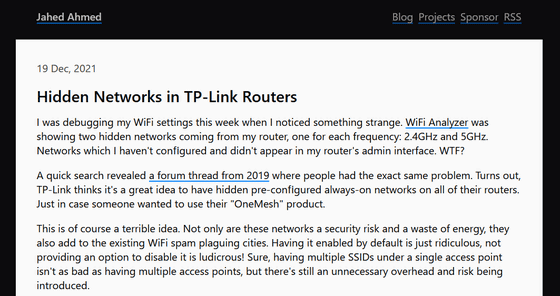It turns out that the Wi-Fi router was building a hidden network without knowing it, why?

by
Some Wi-Fi routers are equipped with a function that allows you to build a 'hidden network' that cannot automatically detect the network on the terminal side. Engineer Jahed Amed reports that he found a hidden network on the TP-Link router, even though he didn't configure it himself.
Hidden Networks in TP-Link Routers | Jahed Ahmed
https://jahed.dev/2021/12/19/hidden-networks-in-tp-link-routers/

As Amed was debugging the Wi-Fi settings, he found that the open source Wi-FI analysis app ' WiFi Analyzer ' had routers forming two hidden networks. This network, of course, wasn't set by Amed and wasn't even visible in the router's management interface.
According to Amed's investigation, there was a person who raised a similar issue to the TP-Link forum in 2019.
Found Archer C7 v5 or Archer A7 v5 is emitting hidden network? Read it to get more details. --Home Network Community
https://community.tp-link.com/en/home/stories/detail/728
According to a post on the forum, when analyzing the band of TP-Link's Wi-Fi router ' Archer C7 V5 ', it is used to build a normal SSID that can be detected and connected by a wireless device and a wireless network compatible with OneMesh. It is said that the SSID to be used is displayed. Of these two SSIDs, the latter SSID for mesh networks was not detected by general wireless devices.


Of course, this hidden network itself is not a bad thing, it is just what TP-Link devices need to configure a mesh network. However, Amed says, 'TP-Link seems to think it's a great idea to hide the pre-configured always-on network on all of its standard OneMesh-enabled routers. Of course, this is a terrible idea. 'Comment.
'These networks are not only a waste of security risk and energy, but they also spur spam attacks over Wi-Fi, which is a problem in urban areas. By default, they are enabled. It's weird, and it's weird not to offer the option to disable it. Sure, having multiple SSIDs on one access point isn't as bad as having multiple access points, but it's unnecessary. There is still the introduction of overhead and risk, 'he said, criticizing how TP-Link configures hidden networks to support OneMesh.
To address this issue, TP-Link released a beta version of the firmware update for the MR600 and MR200 in June 2021. However, it seems that it has not been released for Mr. Amed's router, and although he reverse engineered the firmware backup and searched for a workaround, he said that it could not be solved.
While describing TP-Link's products as 'a trusted brand and close to perfection for their needs,' Amed said that this hidden network issue is appropriate for all models. The problem is that they are not willing to provide a solution. 'This problem is exactly the right to repair,' Amed said, saying that the firmware should be open source and that you should be able to solve the problem yourself.
Related Posts:
in Hardware, Posted by log1i_yk







